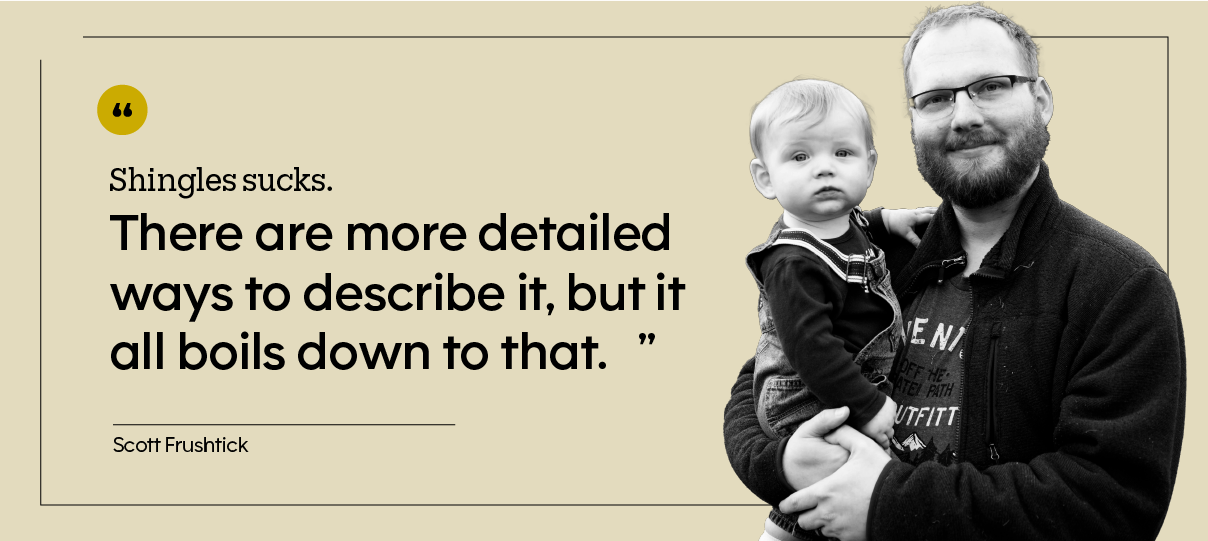Key takeaways:
Shingles is a painful blistering rash caused by the same virus as chickenpox.
Symptoms include sores, pain in the area, itching, fever, and sensitivity.
Valacyclovir (Valtrex) is a kind of antiviral that helps lessen the length and intensity of shingles.
Save on related medications
When people get shingles — the blistering rash caused by the same virus as chickenpox — it hurts.
Shingles itches and burns, and can come along with symptoms like headache, fever, and fatigue.
Antiviral medications like valacyclovir (Valtrex) can help. Valtrex is designed to shorten the length and intensity of the illness. And it’ll work best if you start taking it within 72 hours of getting the shingles rash.
Here’s how three people describe what it’s like to take Valtrex for shingles.
Reducing sores and sensitivity
When 32-year-old North Carolina resident Scott Frushtick got shingles on his right hip, he first thought it was chafing from his new jogging regimen. But what he thought was chafing turned into blistering sores that burst with little pressure.
When he started feeling extreme pain and sensitivity in the area, he realized it was something more serious.
“Shingles sucks,” he says. “There are more detailed ways to describe it, but it all boils down to that.”

He tried taking Tylenol and ibuprofen, which had no effect. Placing lidocaine patches on his sores provided pain relief. They also prevented his waistband from rubbing against the area.
Five days after his symptoms appeared, Scott received a prescription for Valtrex. He isn’t sure if it was the medication or the natural course of the virus — but after 5 days, the sores began to disappear.
But the scarring and sensitivity were still present, even after several months. This lingering pain is known as postherpetic neuralgia (PHN), and it affects up to 20% of people with shingles.
“It’s like a jolt of electricity any time the scars get brushed,” he says.
An eye emergency and full recovery
For Christina DeSanti, shingles started with what she thought was an ingrown hair on her eyebrow.
Christina, who’s 55 and lives in Romona, California, was on vacation in Las Vegas when she noticed it. Over the weekend, her eye began to swell up. By the following Tuesday, her eye hurt so badly that she couldn’t touch it. She developed open sores all over the area up into her hairline. Her lymph nodes were also swollen.
At the time, she remembered that her mother used to get shingles on her face. She called her doctor right away and went in for an appointment. Sure enough, her doctor diagnosed her with shingles, prescribed her Valtrex, and said it was good they caught it so early.
At that point, the shingles had caused her eye to feel itchy and swell so much that she couldn't open it. Christina used calamine lotion to help ease this symptom.
“I was petrified,” Christina says. “I went right from the doctor to CVS and got the prescription and took it right away.”

After 3 days on Valtrex, she began feeling better, and her sores scabbed over. After about a week, she had made a full recovery.
Thinking back on it now, Christina wishes she had thought to get the shingles vaccination, which is the best way to prevent shingles and complications like PHN. She recalls thinking every time she went to the pharmacy that she should get the vaccine. Now, Christina plans to get it.
Making a rash disappear
When Shirley Peroutka of Las Cruces, New Mexico, was 65, she noticed a very itchy raised rash somewhere around her lower back.
At first, she thought it might be poison ivy or gnat bites. In the past, she had experienced bad reactions to both. She had recently gotten the shingles vaccine, so she didn’t think that her symptoms were shingles-related.
After several days, she felt pain around the area of the rash, as well as in her lower left abdomen. The pain gradually grew and became more intense.
“When the pain did not abate after a couple of weeks, I did some Googling and had an ‘ah-hah’ moment when I finally put two and two together: pain plus rash equals shingles,” she says.
Shirley quickly got help from her provider, who confirmed she did have shingles. She got a prescription for Valtrex.

“After maybe a week or slightly less, the pain improved, and the rash crusted over and began to disappear,” she says.
Despite experiencing minor pain for a few more weeks, the worst was over for Shirley.
What does the pharmacist say?

Alyssa Billingsley, PharmD
Director, Pharmacy Content
Valtrex is one of three prescription antiviral medications used to treat shingles. It works by preventing the virus that causes shingles from making copies of itself, which slows the infection from spreading. Valtrex doesn’t cure shingles, but it can help your rash heal faster and lessen pain.
As soon as you notice a shingles rash, it’s important to start a medication like Valtrex as soon as possible. That’s because it’ll work best if you start taking it within 72 hours of the rash. You’ll typically take Valtrex three times a day for 7 days. And if it makes you nauseous, taking your dose with food may help.
Some people have lingering nerve pain even after their rash has healed (called PHN). Valtrex doesn’t prevent this from happening. And the risk of PHN goes up as you get older.
The best way to prevent shingles — and PHN — is to get vaccinated. It’s recommended to get the shingles vaccine, even if you’ve had shingles before.
The shingles vaccine is very effective, but it won’t prevent 100% of shingles cases. Even if you’re vaccinated, it’s important not to delay care if you think you might have it.

Why trust our experts?




















